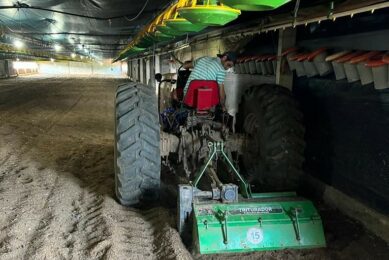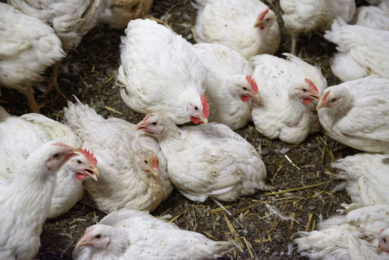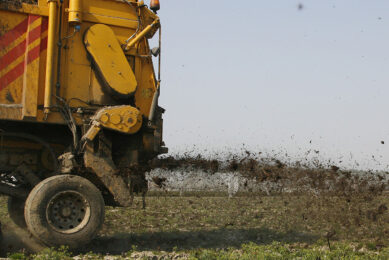Poultry litter management essential for health and performance

Because birds are in constant contact with litter, risk factors associated with poorly managed litter, such as high moisture content, malodour and the prevalence of pathogens, as well as ammonia emissions, will adversely affect the health and performance of chickens – and ultimately producers’ profit – unless proper poultry feeding and litter management practices are adopted.
Intensive poultry farming has resulted in the production of enormous volumes of poultry litter. The disposal of this material is a major concern in terms of its odour and potential health hazards to humans and animals reared in the disposal area, unless the litter is properly managed and safely produced.
With adequate poultry feeding and litter management, serious poultry health problems associated with high moisture and ammonia levels, can be prevented. Economically, high-quality litter can be safely used for many (4 or more) broods of chicken, thereby saving labour and cost. Thereafter, the litter may be sold at an average price of about US$80/tonne to serve as a valuable resource for improved soil fertility, thereby representing an additional source of income for the producer.
Nutritional strategies
The use of cereals rich in soluble non-starch polysaccharides, like rye, barley, or wheat, is associated with litter problems due to the effect on digesta viscosity leading to increased water consumption and faecal moisture. Similarly, rice bran can cause problems with droppings when used to replace sorghum due to the amount of pentosans in the rice bran. The increased use of soybean meal in poultry diets can also affect water consumption and worsen litter problems. The oligosaccharides found in soybean meal also cause faeces to have hygroscopic properties, resulting in greater litter moisture.
Physical form of the diet
Feeding birds with pellets has been shown to result in increased faecal moisture levels and poorer litter quality compared with mash diets, but the latter does not maintain the same broiler performance as pelleted diets. Pelleting still has important advantages in terms of less feed waste, reduced selective feeding, decreased ingredient segregation, the destruction of pathogenic organisms, reduced dustiness and greater utilisation of dietary fibres. Such advantages, therefore, need to be balanced against the adverse effects of pelleting on litter quality.
Dietary protein and amino acids
Feeding reduced protein diets (e.g., 2% less) helps reduce water intake by 3% with a resultant decrease in water excretion and improved litter quality. A reduced level of dietary protein can also reduce nitrogen excretion, with a reduction in ammonia emissions of up to 24%. When diets are fed in pellet form the lysine requirement increases compared to those fed similar diets in mash form, since pelleting increases the productive energy of the diet. It is recommended that the lysine level should be 1.45% here, compared to 1.30% in mash feed.
Dietary fat
Fats from animal sources usually have lower digestibility than those of vegetable origin, as animal fats have more saturated fatty acids. Therefore, the use of fats from animal sources results in excreta with an increased fat content and a reduction in the foot pad health problems associated with high-moisture litter, probably due to the fat having a water-repellent effect on the foot pad skin. This effect, however, warrants a critical assessment of costs when animal fat is used as a substitute for fats of plant origin.
Mineral, vitamins and enzymes
High dietary levels of sodium, potassium and magnesium increase water intake and litter moisture which, in turn, can lead to a greater severity of foot pad dermatitis. In this case, increasing the dietary level of biotin (vitamin B7) may help to reduce the incidence of foot pad dermatitis due to its role in maintaining the skin in optimal condition.
Supplementing with feed enzymes, such as xylanase amylase and protease in combination with probiotic bacteria, decreased litter moisture and reduced the severity of foot pad dermatitis in broilers, especially when diets with high levels of non-starch polysaccharides were used. In birds fed enzyme-supplemented diets, the water content of faeces was reduced by 22-25% compared with controls.
Management practices
Besides striving for optimal nutrition, a well-designed and properly maintained poultry house will help to optimise litter quality, too. Houses with concrete floors will be easier to clean while those with soil floors will be more difficult to handle, so disinfection following the removal of old, wet litter may be an ineffective procedure.
Roofs should be properly insulated or may lead to condensation that drips on the litter, thereby increasing the moisture content. Insulation with a U value of 0.4 W/m2/°C or better is necessary. The moisture problem may also arise from worn nipples that have been used for 5 years or more. The timely replacement of worn nipples, therefore, provides an opportunity to improve litter quality.
Litter type
Several types of litter materials can be used in poultry houses, including chopped straw, sand, shredded paper, rice hulls, corn cobs and peanut hulls. The choice of uncontaminated litter materials will depend on individual circumstances and the availability and cost of materials which will vary in different localities.
Generally, litter should be capable of drying quickly and be soft, compressible and absorbent. As birds may eat some litter, litter materials should be free of corrosive chemicals, disease organisms and moulds that could adversely affect bird health. Litter material should be dust-free, with no more than 15% consisting of particles smaller than 2 mm, and have low thermal conductivity to retain warmth and act as insulation.
Litter treatment
The use of litter additives, such as lime and bentonite, has been shown to decrease moisture content by 4% and reduce various types of pathogens without interfering with the productive performance of birds. The addition of formalin to the litter at 3% may further reduce the microbial population in the litter from 115 to only 1.3 cfu/g. In this study the ammonia level was reduced from 100 to 5 ppm for 3 weeks following the treatment.
Litter treatment using zeolite also enhances the performance of birds by trapping ammonia, thus improving litter and air quality in the poultry house, in addition to its effect of reducing the major culprits in odour production and microbial activities in the litter.
Re-use of litter
As indicated earlier, the re-use of poultry litter saves both labour and costs since several broods of broilers can be raised on the same litter. Re-used litter also has a nutritional advantage. In the bacterial action that takes place, there is considerable synthesis of B-complex vitamins, including vitamin B12, which will help to improve the growth of broiler chickens or the egg production of hens reared on re-used litter.
Infected litter, however, may cause a variety of bacterial and viral diseases if re-used to raise a new brood of chickens, thereby reducing the performance of birds. In a study with broiler chickens, the new litter gave an average body weight of 1.895 kg and the old litter of 1.757 kg with feed conversion ratios of 2.01 and 2.18, respectively. This situation can be improved with a clear determination that the litter is clean and harbours no disease organisms.












